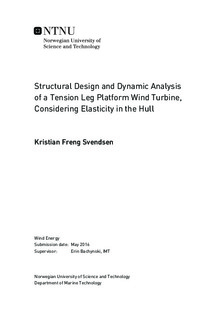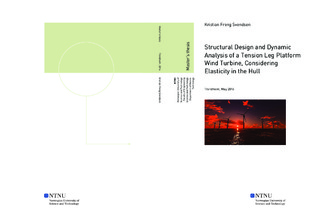| dc.description.abstract | There is an increasing interest in using offshore wind turbines in deeper waters. The tension leg platform wind turbine (TLPWT) is seen as a promising concept for this. Low production costs and limited motions give the TLPWT concept both economic and dynamic advantages. Previous studies regarding dynamic analysis of floating offshore wind turbines have focused on global dynamic analysis with a rigid hull. Novel methods are needed to include both flexibility and correct hydrodynamic loads in the global dynamic analysis. This study presents a basic scantling design and a new method for including the large-volume hydrodynamic loads.
A 3-D panel model was generated for the hull, and radiation and diffraction pressures from first-order potential theory were computed for each panel using WAMIT. A Matlab script was written in which an algorithm integrates the panel pressures and generates frequency-dependent added mass, damping and excitation input for sections of the hull. The method gave exact translational load component magnitudes and slightly underestimated rotational load component magnitudes with respect to WAMIT s output for the hull as a whole.
In order to examine the effects of hull flexibility, a basic scantling design was made for the hull of an existing 5-MW TLPWT design by following industry guidelines. Finite element software was used to estimate the stiffness and an equivalent beam element model was created for the hull. Implementing the equivalent beam model in a global model of the whole TLPWT makes it possible to investigate the hull elasticity s influence on the system s global dynamic properties and internal loads. As expected, the hull elasticity had more significant effects on vertical motions: Simulated decay tests indicated an increase of the heave and pitch natural periods of 43 % and 18 %, respectively.
Time-domain simulations of the flexible model with the novel hydro-loading approach in combined wind-wave environments indicated dynamic amplification of the nacelle motions, tower base bending moment and the tendon tension. An attempt was also made to investigate the dynamic amplification of internal loads in the hull. The results indicated unexpectedly large amplification for certain frequencies, and more research is needed to draw substantiated conclusions. | |

